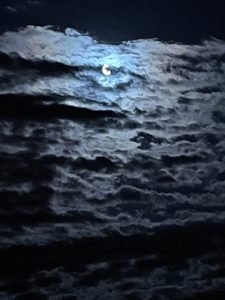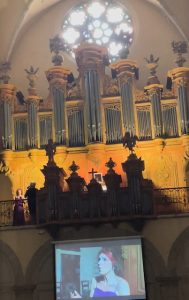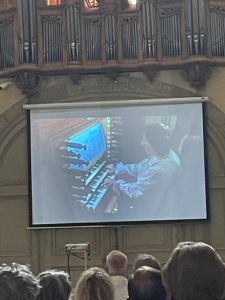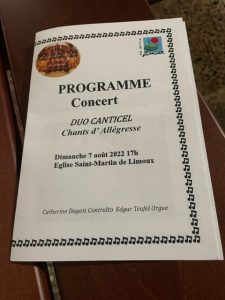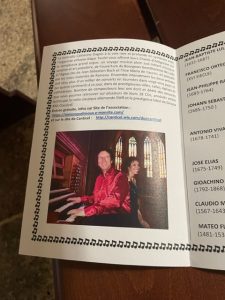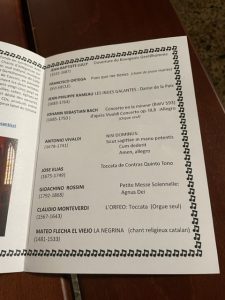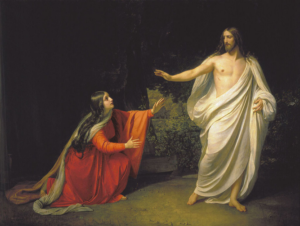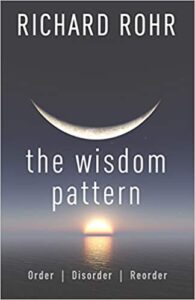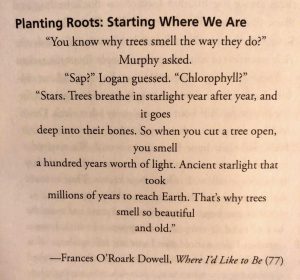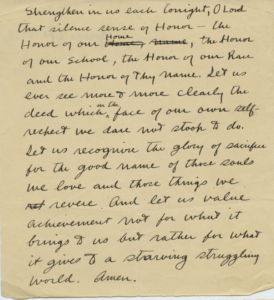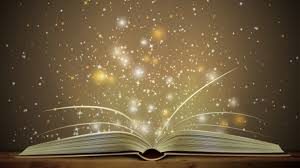Cynthia Bourgeault
Dayle in Limoux – Day #72
September 15, 2022Limoux’s waning moon.
By asking “Whom does my soul serve?” we learn to turn our attention to the deeper purposes of what we do. We enlarge our vision of what’s possible and gradually learn to root our actions in soul.
Bill Plotkin
Could it be that this earthly realm, not in spite of but because of its very density and jagged edges, offers precisely the conditions for the expression of certain aspects of divine love that could become real in no other way? This world does indeed show forth what love is like in a particularly intense and costly way. But when we look at this process more deeply, we can see that those sharp edges we experience as constriction at the same time call forth some of the most exquisite dimensions of love . . . qualities such as steadfastness, tenderness, commitment, forbearance, fidelity, and forgiveness. These mature and subtle flavors of love have no real context in a realm where there are no edges and boundaries, where all just flows. But when you run up against the hard edge and have to stand true to love anyway, what emerges is a most precious taste of pure divine love.
Cynthia Bourgeault, author, ‘The Meaning of Mary Magdalene’
︶⁀°• •° ⁀︶
From author and scholar Jean Houston:
Once you answer the call to a larger life, there is no turning back. Indeed, each of us might usefully consider where we find ourselves right now on the cycle of our own particular journeys. Have you heard a call to the larger life? Have you refused it, and if so, why? Have you accepted the call but then met with monsters of recalcitrance who refused to let you pass across the threshold to your own deeper capacities and possible life? Did you finally outwit these monsters and get across? Are you caught in the belly of the whale through despair, depression, or just plain sloth? Have unusual allies or helpers shown up? A telephone call at the right time? A book falling open at an important passage? Do you find yourself in the midst of the road of trials, and if so, do you experience it as full of adventures or as just one damn crisis after another? Is there awaiting you a sacred marriage or a transformational friendship? Do you feel the yearning for the inner beloved of the soul? Are you seeking atonement or attunement with your father or mother . . .? Are you finding a boon, an insight, a project that may bring some healthy solution to your own and the world’s problems? . . . Or perhaps you find yourself, like the rest of us, in several different stages of the journey at the same time.
From the Center for Action & Contemplation, ‘experience a version of this practice through video and sound.’ Turn it up so you can hear the birds. :)
Being in a different country, immersed in a second language and culture, the grail journey is seemingly more acute…magnified. Yet, these journeys are available to us anywhere…time or place. The calling is profound. Listening, imperative. And then, time seemingly elongates…expands…where the stories we once carried seem so much quieter, smaller. Maybe it isn’t that life is short, but that we live it fast…choices and consequences and ‘next.’ As Cynthia shares, it’s the ‘density and hard edges’ of this iteration in time that gives us the grace and possibility…mercy?…to examine the most exquisite dimensions of love within the constructs we create with fear, rage, and violence, the dimensions of
- steadfastness
- tenderness
- commitment
- forbearance
- fidelity
- forgiveness
As Cynthia reminds us, “That’s our business down here. That’s what we’re here for.”
Saint-Martin’s in Limoux, for Ukraine.
À bientôt.
🌻
Dayle in Limoux – Day #33
August 7, 2022To be a projection of higher value. As I begin this day, I am open to receive. May my mind stay open and may I not deviate from things that are pure (Cathar) and true. Beyond the illusions of this worldly plane. I surrender to you my doings this day.
From Fr Richard Rohr, The Center for Action & Contemplation
‘In his book Coming to Our Senses, historian Morris Berman makes the point that our first experience of being alive is not through the visual or auditory experience of knowing ourselves through other people’s responses; it is primarily felt in the body. He calls this kinesthetic knowing. We know ourselves in the security of those who hold us, skin to skin. This early encounter is not so much heard, seen, or thought. It’s felt. That’s the original knowing.
Hopefully, our caregivers’ early gaze told us we were foundationally beloved. But when we inevitably begin to see ourselves through eyes that compare, judge, and dismiss, then we need spirituality to help heal the brokenness of our identity and our world.
It parts the veil and tells us that our primal experience was trustworthy. It tells us that we are beloved, whether we received that mirroring gaze or not. It reassures us that we live in a benevolent universe, and it is on our side.
The universe, it assures us, is radical grace.’
︶⁀°• •° ⁀︶
How do you dream?
‘In Bhutan, they dream of rainbows.
In countries throughout the world, even in countries where there are no snakes, the most common dream is one based on our (it must be) genetic fear of snakes.
But in Bhutan, they dream of rainbows.
The dreams might be consistent, but the way we talk about them clearly isn’t. Perhaps the dreams we remember and talk about have something to do with culture.
Conversations are contagious.’
-Seth Godin
︶⁀°• •° ⁀︶
‘It is fashionable to be pessimistic about humankind — look at the assorted messes we’ve got ourselves into, and the undoubted evil that pervades the whole earth: war, poverty, child abuse, slavery, drugs, corruption of various sorts, racism and sexism, bigotry, hypocrisy — the list is depressingly long. Finding it impossible to comprehend that a good God would be concerned with such a hell, the Gnostic developed the idea that there were two Gods, the evil one who ruled the Earth, and the good God who lived in Heaven. Undoubtedly almost every individual who has ever lived has had some experience of this life as living hell, but without necessarily adding to it him, or herself.
[…]
Free of priests, gurus and dogma, the progress of our spirit is, perhaps terrifyingly, nothing more or less than our own responsibility.’ [Shades of Emerson.]
-Lynn Picknett, ‘Mary Magdalene’
‘The imaginal realm is real, and through it you will never be separated from anyone or anything you have ever loved, for love is the ground in which you live and move and have your being. This is the message that Mary Magdlane has perennials to bring. This is the message we most need to hear.’
[…]
‘It is clear that Mary Magdalene knew a good deal about that realm. At that spiritual tipping point where “no longer the object of my affection, he has become the subject of my truth,” a new energy emerges: pure (Cathar) creativity and effortless action. This is the “spiritual procreativity” described by both the Gospel of Philip and the poet Rilke.’
-Cynthia Bourgeault
‘The Cathars left behind no magnificent church architecture, for they believed that the essence of Christ’s teaching was humility and an indifference to material possessions. The temple of God lay within us for He was approached through the heart.’
-Margaret Long, author
︶⁀°• •° ⁀︶
Went to a wonderful concert tonight for the community at Saint-Martin’s. The organist and the alto soprano were beautifully in tandem. And the acoustics! Those 12th century builders…they knew. :)
At one point in history, Saint-Martin’s was actually a cathedral. In 1316, after the Albigensian Crusade, Pope John XXII created a small diocese, centered here in Limoux.
╰ღ╮╭ღ╯
Reading in France tonight about the U.S. Senate vote today:
Senate Democrats pass $740 billion tax, climate and health care bill. [Axios]
Jeff Stein, White House economics reporter for The Washington Post, writing:
Biggest-ever climate bill: Massive industry clean energy money; $80B for EVs, heat pumps, home solar installation
Up to $7,500 to buy an EV — Up to $2K for heat pump — 30% off home rooftop solar — $840 for electric cooktop — Up to $9K for electric panel/home insulation
The planet continues to burn, and climate breakdown is painfully and frighteningly real.
From VOX:
The Senate just passed one of the biggest bills to fight climate change, ever.
What’s in the “game changer” climate bill nobody saw coming.
by, Rebecca Leber
Aug 7, 2022
David Goldman/AP
‘After nearly 18 months of haggling and 15-straight hours of weekend votes, Senate Democrats passed the Inflation Reduction Act on a strict party-line vote on Sunday.
The bill contains $369 billion in funding for clean energy and electric vehicle tax breaks, domestic manufacturing of batteries and solar panels, and pollution reduction. It is the single most important step the US has ever taken to combat the climate crisis. And arguably, it’s one of the single biggest investments ever made on climate in the world.
If the bill’s policies work as intended, it would push American consumers and industry away from reliance on fossil fuels, penalize fossil fuel companies for excess emissions of methane, and inject needed funds into pollution cleanup.
The bill uses tax credits to incentivize consumers to buy electric cars, electric HVAC systems, and other forms of cleaner technology, leading to less emissions from cars and electricity generation, and includes incentives for companies to manufacture that technology in the United States. It also includes money for a host of other climate priorities, like investing in forest and coastal restoration and in resilient agriculture.
These investments, spread out over the next decade, are likely to cut pollution by around 40 percent below 2005 levels by 2030, according to three separate analyses by economic modelers at Rhodium Group, Energy Innovation, and Princeton University. The legislation helps move the US a little closer to its stated goal of cutting pollution in half within the decade.’
[Full piece]
And we can all do our part to contribute to the shift to save and heal our Gaia. We must.
YES! Magazine
“Earth repair is a participatory sport: a grassroots response to evolving global crises.”
While mainstream environmentalism has historically pursued either preservation or conservation, Schwartz’s new book, The Reindeer Chronicles (Chelsea Green 2020) explores a third option: regeneration.
She looks at community efforts to restore ecosystems the world over. “We’ve been trained to believe that finding solutions is a job for the experts,” she writes, but “Earth repair is a participatory sport: a grassroots response to evolving global crises.”
We may not know what the future climate is going to look like, and she acknowledges that not knowing is really hard. “But we’ve got to try,” she says matter of factly. “We’re here now … Just start.”
“There is no natural law that says profit must supersede other types of reward,” she writes. “The truth is, we are what we measure—or at least our actions are largely determined by how we gauge success. What if environmental healing, social engagement, and a commitment to the future governed our companies and institutions, and therefore our work lives?”
“We’ve all got places,” she says. “Places have their own ecological logic. Let’s do what we can where we are and learn from each other.” That idea of connecting with place and community is central to her worldview. “The ‘we’ who can address climate change is everybody,” she says.
“There is no one size fits all for climate action.” Schwartz says we need to protest oil companies and make art and grow healthy food and feed one another and, in her case, write—all using our respective skills to imagine a more resilient world.’
#
The Guardian
Photograph: SbytovaMN/Getty Images/iStockphoto
Clever use of water in the garden saves untold time and effort
You’d be amazed at how much time some gardeners spend watering
- Plant in the ground, not pots
- Use Mulch
- Water in the cool of the evening
“At first there’s no path…and then someone bravely makes a step, and others join…just start.”
-Jacqueline Novogratz
🌏 ℒℴve
À bientôt.
❀
Mary of Magdala
July 22, 2021‘…the first great bough, the fruit of love & compassion, the foundation of all things.’ -Mary Magdalene ღ
Today, the feast day of St. Mary Magdalene.
Today is the feast day of St. Mary Magdalene, one of the most misunderstood of all saints. In this excerpt from A Jesuit Off-Broadway, I relate her (true) tale and how her life intersected with that of the gifted actress who would portray her in the play “The Last Days of Judas Iscariot.”
America/The Jesuit Review
Who was Mary of Magdala?
by James Martin, S.J.
One of the note cards from the cathedral gift shop in Los Angeles struck a chord with the actress Yetta Gottesman, because it depicted her character, Mary Magdalene. The delicate tapestry presented a young woman with close-cropped black hair, her head bowed in prayer, her hands clasped to her chin.
Thanks in great part to Dan Brown’s best-selling novel The Da Vinci Code, interest in the historical Mary Magdalene has risen stratospherically during the past few years. As with her fellow disciple, Judas, we know very little about her. Jesus cast seven demons out of her (we don’t know how these demons had manifested themselves in her behavior); she remained at the cross with two other women when the other (male) disciples had all fled; she watched Jesus die; and she was the first one to whom Jesus appeared after the Resurrection. In a touching scene on Easter morning, a grieving Mary initially mistakes the risen Jesus for the local gardener.
Even with these distinguished credentials, Mary Magdalene (the name means “of Magdala,” a town in Galilee) gradually became known as a prostitute, though there is no mention of this in the Gospels. (The word maudlin comes from her name, presumably the result of her grieving for a sinful past.) The most benign explanation for this confusion over Mary’s identity is that there is a veritable crowd of Marys in the Gospel stories (besides Mary, the mother of Jesus, there is Mary of Bethany and Mary, the wife of Clopas). Mary Magdalene was also, oddly, conflated with a woman who had bathed Jesus’ feet with her tears, dried them with her hair, and then anointed them with oil. In AD 591, Pope Gregory I preached a sermon in which he proclaimed, “She whom Luke calls the sinful woman, whom John calls Mary, we believe to be the Mary from whom seven devils were ejected according to Mark.”
This inaccurate identification became more or less church teaching for at least a millennium.
A less benign interpretation of this “confusion” is that the early church was threatened, even horrified, by the stunning example of a woman among the early disciples. Strictly based on the evidence in the Gospels, Mary Magdalene enjoyed an exalted standing. She was not only the first one to whom Jesus appeared after the Resurrection, but also the one who proclaimed the news of his resurrection to the other disciples, including those who would be the leaders of the early church communities: Peter, James, Andrew, and the rest.
Thus comes Mary’s traditional title: “Apostle to the Apostles.” Her fidelity to Jesus during the Crucifixion, as well as Jesus’ appearance to her, are marks of distinction that place her, at least in terms of her faith, above the men. Some of the “extracanonical,” or “apocryphal,” gospels (that is, those not included by the early church councils with the traditional four Gospels) picture her as the most favored of all the disciples. “[Christ loved] her more than all the disciples,” says the text known as The Gospel of Philip.
Full read:
https://www.americamagazine.org/faith/2011/07/22/who-was-mary-magdala
[Image: Thomas Merton]
Cynthia Bourgeault:
“Mary Magdalene belongs to the great worldwide stream of spiritual awakening and has nothing whatsoever to do with organized religion.
If we are serious about activating Mary Magdalene’s wisdom presence within contemporary Christianity, the first step is to increase her visibility within the liturgy, particularly during Holy Week, where her presence is so crucial to understanding the Paschal Mystery as an act of redeeming ℒℴve.
I would like to see the entire Holy Week liturgy reframed around two parallel anointings…at Bethany and in the garden of the resurrection…which so powerfully convey the energy of transformative love.
Early Easter morning ceremonially enacted, rather than merely read, the gospel account of Mary Magdalene’s visit to the tomb. The basic ceremony, the Visitatio Sepulchri, has been around since the tenth century; it merely needs to be returned to active duty.
Mary Magdalene weaves into one whole cloth those strands that have traditionally been kept so stringently separated: conscious ℒℴve, healing, kenotic surrender, the feminine, singleness, transformation. To touch any part of the this hologram is to invoke all the rest.
We do not know for certain what happened to Mary Magdalene after the resurrection. The gospel bearing her name confirms that her spiritual leadership was honored in a least some circles of early Christianity. She may well have sojourned in France. What we do know for certain is that the fragrance of her presence did not disappear from Christianity. In mysticism and allegory, in art and folklore, in esoteric circles…all veiled, but pointing like a finger at the moon…her mysterious alchemical feminine was kept alive. Now at last, in our own times, it comes above ground again, asking us to awaken yet again to the morning of the resurrection and find ourselves in the garden, awaiting the encounter that can change our institutional hearts.
The imaginal realm is real, and through it you will never be separated from any one or anything you have ever loved, for ℒℴve is the ground in which you live and and move and have your being. This is the message that Mary Magdalene has perennially to bring. This is the message we most need to hear.”
‘In 591 Pope Gregory claimed that Mary of Magdala was a prostitute, a misconception that remains to this day. In 2016 she was named by the Vatican as the apostle of the apostles, their equal.’
-Written by Helen Edmundson and Philippa Goslett. Directed by Garth Davis.
https://www.rogerebert.com/reviews/mary-magdalene-2019
“As someone who watched it twice in 24 hours, ‘Mary Magdalene’ moved me in a way that no previous film about Christianity ever has.
Mary finds a place in the world and a cause in which to place her profound empathy. She was not just any spectator, this telling argues, so much as proof that at the core of Jesus’ teachings is a feminine influence.” -Nick Allen
[Must see.]
Redeeming ℒℴve through the feminine.
April 3, 2021[Image: Thomas Merton]
Cynthia Bourgeault:
“Mary Magdalene belongs to the great worldwide stream of spiritual awakening and has nothing whatsoever to do with organized religion.
If we are serious about activating Mary Magdalene’s wisdom presence within contemporary Christianity, the first step is to increase her visibility within the liturgy, particularly during Holy Week, where her presence is so crucial to understanding the Paschal Mystery as an act of redeeming ℒℴve.
I would like to see the entire Holy Week liturgy reframed around two parallel anointings…at Bethany and in the garden of the resurrection…which so powerfully convey the energy of transformative love.
Early Easter morning ceremonially enacted, rather than merely read, the gospel account of Mary Magdalene’s visit to the tomb. The basic ceremony, the Visitatio Sepulchri, has been around since the tenth century; it merely needs to be returned to active duty.
Mary Magdalene weaves into one whole cloth those strands that have traditionally been kept so stringently separated: conscious ℒℴve, healing, kenotic surrender, the feminine, singleness, transformation. To touch any part of the this hologram is to invoke all the rest.
We do not know for certain what happened to Mary Magdalene after the resurrection. The gospel bearing her name confirms that her spiritual leadership was honored in a least some circles of early Christianity. She may well have sojourned in France. What we do know for certain is that the fragrance of her presence did not disappear from Christianity. In mysticism and allegory, in art and folklore, in esoteric circles…all veiled, but pointing like a finger at the moon…her mysterious alchemical feminine was kept alive. Now at last, in our own times, it comes above ground again, asking us to awaken yet again to the morning of the resurrection and find ourselves in the garden, awaiting the encounter that can change our institutional hearts.
The imaginal realm is real, and through it you will never be separated from any one or anything you have ever loved, for ℒℴve is the ground in which you live and and move and have your being. This is the message that Mary Magdalene has perennially to bring. This is the message we most need to hear.”
‘In 591 Pope Gregory claimed that Mary of Magdala was a prostitute, a misconception that remains to this day. In 2016 she was named by the Vatican as the apostle of the apostles, their equal.’
-Written by Helen Edmundson and Philippa Goslett. Directed by Garth Davis.
https://www.rogerebert.com/reviews/mary-magdalene-2019
“As someone who watched it twice in 24 hours, ‘Mary Magdalene’ moved me in a way that no previous film about Christianity ever has.
Mary finds a place in the world and a cause in which to place her profound empathy. She was not just any spectator, this telling argues, so much as proof that at the core of Jesus’ teachings is a feminine influence.” -Nick Allen
Sophia.
February 26, 2021Cynthia Bourgeault, An Introductory Wisdom School: Course Transcript and Companion Guide (Wisdom Way of Knowing: 2017), 2. Please note: Today is the last day to register for Cynthia’s Introductory Wisdom School online course.
Sophia: Koinē Greek: Σοφíα “Wisdom“, Coptic: ⲧⲥⲟⲫⲓⲁ “the Sophia”
W I S D O M
Center for Action & Contemplation
Fr Richard Rohr:
‘Wisdom is clearly more than mere intelligence, knowledge of facts, or information. Wisdom is more synthesis than analysis, more paradoxical than linear, more a dance than a march. In order to grow in wisdom, we need to move beyond cerebral, rational knowing. As wisdom teacher Cynthia Bourgeault puts it: “Wisdom is not knowing more, but knowing with more of you, knowing deeper.” I’ve created a list of seven “ways of knowing” that together can move us toward greater wisdom. Here are the first four:
Intellect: The lens that we most associate with knowing is intellectualknowing. It’s the result of formal education and it has to do with science, reason, logic, and what we call intelligence. Most of us are trained to think that it is the only way of knowing or the superior way of knowing. Yet that isn’t necessarily true. Seeing intellectual intelligence as the best or only way of knowing is actually a great limitation.
Will: The second way of knowing is volitional knowing. It comes from making choices, commitments, and decisions, then sticking with them, and experiencing them at different stages. Anyone who has made and then kept vows knows what I’m talking about. It is a knowing that comes from making choices and the very process of struggling with the choices. This knowing is a kind of cumulative knowing that emerges over time. The Franciscan scholar John Duns Scotus (1266–1308) felt that volitional knowing, or will, was higher and closer to love than intellectual knowing.
Emotion: Great emotions are especially powerful teachers. Love, ecstasy, hatred, jealousy, fear, despair, anguish: each have their lessons. Even anger and rage are great teachers, if we listen to them. They have so much power to reveal our deepest self to ourselves and to others, yet we tend to consider them negatively. I would guess that people die and live much more for emotional knowing than they ever will for intellectual, rational knowing. To taste these emotions is to live in a new reality afterward, with a new ability to connect.
Senses: Bodily or sensory knowing comes through the senses, by touching, moving, smelling, seeing, hearing, breathing, tasting—and especially at a deep or unconscious level. Becoming aware of our senses in a centered way allows us to awaken, to listen, to connect. It allows us to know reality more deeply, on our body’s terms instead of our brain’s terms. It is no surprise that Jesus touched most of the people he healed. Something very different is communicated and known through physical touch, in contrast with what is communicated through mere words.
Also,
‘Here are the three further “ways of knowing” that can allow us to access greater wisdom:’
Images: Imaginal knowing is the only way that the unconscious can move into consciousness. It happens through fantasy, through dreams, through symbols, where all is “thrown together” (sym-ballein in Greek). It happens through pictures, events, and well-told stories. It happens through poetry, where well-chosen words create an image that, in turn, creates a new awareness—that was in us already. We knew it, but we didn’t know it. We must be open to imaginal knowing because the work of transformation will not be done logically, rationally, or cerebrally. Our intellectual knowing alone is simply not adequate to the greatness and the depth of the task.
Aesthetic: In some ways, aesthetic knowing is the most attractive, but I think it’s often the least converting. Art in all its forms so engages us and satisfies us that many go no deeper. Still, aesthetic knowing is a central and profound way of knowing. I’ve seen art lead to true changes of consciousness. I have seen people change their lives in response to a novel, a play, a piece of music, or a movie like Dead Man Walking. Their souls were prepared, and God got in through the right metaphor at the right time. They saw their own stories clarified inside of a larger story line.
Epiphany: The last way of knowing, which I’d think religion would prefer and encourage, is epiphanic knowing. An epiphany is a parting of the veil, a life-changing manifestation of meaning, the eureka of awareness of self and the Other. It is the radical grace which we cannot manufacture or orchestrate. There are no formulas which ensure its appearance. It is always a gift, unearned, unexpected, and larger than our present life. We cannot manufacture epiphanies. We can only ask for them, wait for them, expect them, know they are given, keep out of the way, and thank Someone afterward.
“A universal pattern can be found in all societies and in fact in all of creation. We see it in the seasons of the year; the stories of Scripture; the life, death, and resurrection of Jesus; the rise and fall of civilizations; and even in our own lives. In this new version of one of his earlier books, Father Richard Rohr illuminates the way understanding and embracing this pattern can give us hope in difficult times and the courage to push through messiness and even great chaos to find a new way of being in the world.”
Adapted from Richard Rohr, The Wisdom Pattern: Order, Disorder, Reorder (Franciscan Media: 2020), 121–127
Read aloud.
April 17, 2020Starlight. Ancient, starlight.
Hope is the main impulse of life. —Ilia Delio
Mystical hope. -Cynthia Bourgeault
?
Compassion, love and truth.
February 22, 2020
‘Human nature is not evil. All pleasure is not wrong. All spontaneous desires not selfish. The doctrine of original sin does not mean that human nature has been completely corrupted and that man’s freedom is always inclined to sin.
Man is neither a devil nor an angel. He is not pure spirit, but a being of flesh and spirit, subject to error and malice, but basically inclined to seek truth and goodness. He is, indeed, a sinner: but their hearts respond to love and grace. It also responds to the goodness and to the need of his fellowman.’
-Thomas Merton, Life and Holiness [1963]
If we over-use the intellectual center, then our work lies in bringing the emotional and moving centers fully online and integrating them. Wisdom is a way of knowing that goes beyond one’s mind, one’s rational understanding, and embraces the whole of a person: mind, heart, and body. These three centers must all be working, and working in harmony, as the first prerequisite to the Wisdom way of knowing.
—Cynthia Bourgeault
This essay is excerpted from W.E.B. Du Bois’s 1903 book, The Souls of Black Folk.
O water, voice of my heart, crying in the sand,
All night long crying with a mournful cry,
As I lie and listen, and cannot understand
The voice of my heart in my side or the voice of the sea,
O water, crying for rest, is it I, is it I?
All night long the water is crying to me.Unresting water, there shall never be rest
Till the last moon droop and the last tide fail,
And the fire of the end begin to burn in the west;
And the heart shall be weary and wonder and cry like the sea,
All life long crying without avail,
As the water all night long is crying to me.
— Arthur Symons
“Between me and the other world there is ever an unasked question: unasked by some through feelings of delicacy; by others through the difficulty of rightly framing it. All, nevertheless, flutter round it. They approach me in a half-hesitant sort of way, eye me curiously or compassionately, and then, instead of saying directly, How does it feel to be a problem? they say, I know an excellent colored man in my town; or, I fought at Mechanicsville; or, Do not these Southern outrages make your blood boil? At these I smile, or am interested, or reduce the boiling to a simmer, as the occasion may require. To the real question, How does it feel to be a problem? I answer seldom a word.
And yet, being a problem is a strange experience,—peculiar even for one who has never been anything else, save perhaps in babyhood and in Europe. It is in the early days of rollicking boyhood that the revelation first bursts upon one, all in a day, as it were. I remember well when the shadow swept across me. I was a little thing, away up in the hills of New England, where the dark Housatonic winds between Hoosac and Taghkanic to the sea. In a wee wooden schoolhouse, something put it into the boys’ and girls’ heads to buy gorgeous visiting-cards—ten cents a package—and exchange. The exchange was merry, till one girl, a tall newcomer, refused my card,—refused it peremptorily, with a glance. Then it dawned upon me with a certain suddenness that I was different from the others; or like, mayhap, in heart and life and longing, but shut out from their world by a vast veil. I had thereafter no desire to tear down that veil, to creep through; I held all beyond it in common contempt, and lived above it in a region of blue sky and great wandering shadows. That sky was bluest when I could beat my mates at examination-time, or beat them at a foot-race, or even beat their stringy heads. Alas, with the years all this fine contempt began to fade; for the worlds I longed for, and all their dazzling opportunities, were theirs, not mine. But they should not keep these prizes, I said; some, all, I would wrest from them. Just how I would do it I could never decide: by reading law, by healing the sick, by telling the wonderful tales that swam in my head,—some way. With other black boys the strife was not so fiercely sunny: their youth shrunk into tasteless sycophancy, or into silent hatred of the pale world about them and mocking distrust of everything white; or wasted itself in a bitter cry, Why did God make me an outcast and a stranger in mine own house? The shades of the prison-house closed round about us all: walls strait and stubborn to the whitest, but relentlessly narrow, tall, and unscalable to sons of night who must plod darkly on in resignation, or beat unavailing palms against the stone, or steadily, half hopelessly, watch the streak of blue above.
After the Egyptian and Indian, the Greek and Roman, the Teuton and Mongolian,
the Negro is a sort of seventh son, born with a veil, and gifted with second-sight in this American world,—a world which yields him no true self-consciousness, but only lets him see himself through the revelation of the other world. It is a peculiar sensation, this double-consciousness, this sense of always looking at one’s self through the eyes of others, of measuring one’s soul by the tape of a world that looks on in amused contempt and pity.
One ever feels his two-ness,—an American, a Negro; two souls, two thoughts, two unreconciled strivings; two warring ideals in one dark body, whose dogged strength alone keeps it from being torn asunder.
The history of the American Negro is the history of this strife,—this longing to attain self-conscious manhood, to merge his double self into a better and truer self. In this merging he wishes neither of the older selves to be lost. He would not Africanize America, for America has too much to teach the world and Africa. He would not bleach his Negro soul in a flood of white Americanism, for he knows that Negro blood has a message for the world. He simply wishes to make it possible for a man to be both a Negro and an American, without being cursed and spit upon by his fellows, without having the doors of Opportunity closed roughly in his face.
This, then, is the end of his striving: to be a co-worker in the kingdom of culture, to escape both death and isolation, to husband and use his best powers and his latent genius. These powers of body and mind have in the past been strangely wasted, dispersed, or forgotten.
The shadow of a mighty Negro past flits through the tale of Ethiopia the Shadowy and of Egypt the Sphinx. Throughout history, the powers of single black men flash here and there like falling stars, and die sometimes before the world has rightly gauged their brightness. Here in America, in the few days since Emancipation, the black man’s turning hither and thither in hesitant and doubtful striving has often made his very strength to lose effectiveness, to seem like absence of power, like weakness. And yet it is not weakness,—it is the contradiction of double aims. The double-aimed struggle of the black artisan—on the one hand to escape white contempt for a nation of mere hewers of wood and drawers of water, and on the other hand to plough and nail and dig for a poverty-stricken horde—could only result in making him a poor craftsman, for he had but half a heart in either cause. By the poverty and ignorance of his people, the Negro minister or doctor was tempted toward quackery and demagogy; and by the criticism of the other world, toward ideals that made him ashamed of his lowly tasks. The would-be black savant was confronted by the paradox that the knowledge his people needed was a twice-told tale to his white neighbors, while the knowledge which would teach the white world was Greek to his own flesh and blood. The innate love of harmony and beauty that set the ruder souls of his people a-dancing and a-singing raised but confusion and doubt in the soul of the black artist; for the beauty revealed to him was the soul-beauty of a race which his larger audience despised, and he could not articulate the message of another people. This waste of double aims, this seeking to satisfy two unreconciled ideals, has wrought sad havoc with the courage and faith and deeds of ten thousand thousand people,—has sent them often wooing false gods and invoking false means of salvation, and at times has even seemed about to make them ashamed of themselves.
Away back in the days of bondage they thought to see in one divine event the end of all doubt and disappointment; few men ever worshipped Freedom with half such unquestioning faith as did the American Negro for two centuries. To him, so far as he thought and dreamed, slavery was indeed the sum of all villainies, the cause of all sorrow, the root of all prejudice; Emancipation was the key to a promised land of sweeter beauty than ever stretched before the eyes of wearied Israelites. In song and exhortation swelled one refrain—Liberty; in his tears and curses the God he implored had Freedom in his right hand. At last it came,—suddenly, fearfully, like a dream. With one wild carnival of blood and passion came the message in his own plaintive cadences:—
“Shout, O children!
Shout, you’re free!
For God has bought your liberty!”
Years have passed away since then,—ten, twenty, forty; forty years of national life, forty years of renewal and development, and yet the swarthy spectre sits in its accustomed seat at the Nation’s feast. In vain do we cry to this our vastest social problem:—
“Take any shape but that, and my firm nerves
Shall never tremble!”The Nation has not yet found peace from its sins; the freedman has not yet found in freedom his promised land. Whatever of good may have come in these years of change, the shadow of a deep disappointment rests upon the Negro people,—a disappointment all the more bitter because the unattained ideal was unbounded save by the simple ignorance of a lowly people.
The first decade was merely a prolongation of the vain search for freedom, the boon that seemed ever barely to elude their grasp,—like a tantalizing will-o’-the-wisp, maddening and misleading the headless host.
The holocaust of war, the terrors of the Ku-Klux Klan, the lies of carpet-baggers, the disorganization of industry, and the contradictory advice of friends and foes, left the bewildered serf with no new watchword beyond the old cry for freedom. As the time flew, however, he began to grasp a new idea. The ideal of liberty demanded for its attainment powerful means, and these the Fifteenth Amendment gave him. The ballot, which before he had looked upon as a visible sign of freedom, he now regarded as the chief means of gaining and perfecting the liberty with which war had partially endowed him.
And why not? Had not votes made war and emancipated millions? Had not votes enfranchised the freedmen? Was anything impossible to a power that had done all this? A million black men started with renewed zeal to vote themselves into the kingdom. So the decade flew away, the revolution of 1876 came, and left the half-free serf weary, wondering, but still inspired. Slowly but steadily, in the following years, a new vision began gradually to replace the dream of political power,—a powerful movement, the rise of another ideal to guide the unguided, another pillar of fire by night after a clouded day. It was the ideal of “book-learning”; the curiosity, born of compulsory ignorance, to know and test the power of the cabalistic letters of the white man, the longing to know. Here at last seemed to have been discovered the mountain path to Canaan; longer than the highway of Emancipation and law, steep and rugged, but straight, leading to heights high enough to overlook life.
Up the new path the advance guard toiled, slowly, heavily, doggedly; only those who have watched and guided the faltering feet, the misty minds, the dull understandings, of the dark pupils of these schools know how faithfully, how piteously, this people strove to learn. It was weary work. The cold statistician wrote down the inches of progress here and there, noted also where here and there a foot had slipped or some one had fallen. To the tired climbers, the horizon was ever dark, the mists were often cold, the Canaan was always dim and far away. If, however, the vistas disclosed as yet no goal, no resting-place, little but flattery and criticism, the journey at least gave leisure for reflection and self-examination; it changed the child of Emancipation to the youth with dawning self-consciousness, self-realization, self-respect. In those sombre forests of his striving his own soul rose before him, and he saw himself,—darkly as through a veil; and yet he saw in himself some faint revelation of his power, of his mission. He began to have a dim feeling that, to attain his place in the world, he must be himself, and not another. For the first time he sought to analyze the burden he bore upon his back, that dead-weight of social degradation partially masked behind a half-named Negro problem. He felt his poverty; without a cent, without a home, without land, tools, or savings, he had entered into competition with rich, landed, skilled neighbors. To be a poor man is hard, but to be a poor race in a land of dollars is the very bottom of hardships. He felt the weight of his ignorance,—not simply of letters, but of life, of business, of the humanities; the accumulated sloth and shirking and awkwardness of decades and centuries shackled his hands and feet. Nor was his burden all poverty and ignorance. The red stain of bastardy, which two centuries of systematic legal defilement of Negro women had stamped upon his race, meant not only the loss of ancient African chastity, but also the hereditary weight of a mass of corruption from white adulterers, threatening almost the obliteration of the Negro home.
A people thus handicapped ought not to be asked to race with the world, but rather allowed to give all its time and thought to its own social problems. But alas! while sociologists gleefully count his bastards and his prostitutes, the very soul of the toiling, sweating black man is darkened by the shadow of a vast despair. Men call the shadow prejudice, and learnedly explain it as the natural defence of culture against barbarism, learning against ignorance, purity against crime, the “higher” against the “lower” races. To which the Negro cries Amen! and swears that to so much of this strange prejudice as is founded on just homage to civilization, culture, righteousness, and progress, he humbly bows and meekly does obeisance. But before that nameless prejudice that leaps beyond all this he stands helpless, dismayed, and well-nigh speechless; before that personal disrespect and mockery, the ridicule and systematic humiliation, the distortion of fact and wanton license of fancy, the cynical ignoring of the better and the boisterous welcoming of the worse, the all-pervading desire to inculcate disdain for everything black, from Toussaint to the devil,—before this there rises a sickening despair that would disarm and discourage any nation save that black host to whom “discouragement” is an unwritten word.
But the facing of so vast a prejudice could not but bring the inevitable self-questioning, self-disparagement, and lowering of ideals which ever accompany repression and breed in an atmosphere of contempt and hate. Whisperings and portents came borne upon the four winds: Lo! we are diseased and dying, cried the dark hosts; we cannot write, our voting is vain; what need of education, since we must always cook and serve? And the Nation echoed and enforced this self-criticism, saying: Be content to be servants, and nothing more; what need of higher culture for half-men? Away with the black man’s ballot, by force or fraud,—and behold the suicide of a race! Nevertheless, out of the evil came something of good,—the more careful adjustment of education to real life, the clearer perception of the Negroes’ social responsibilities, and the sobering realization of the meaning of progress.
So dawned the time of Sturm und Drang: storm and stress to-day rocks our little boat on the mad waters of the world-sea; there is within and without the sound of conflict, the burning of body and rending of soul; inspiration strives with doubt, and faith with vain questionings. The bright ideals of the past,—physical freedom, political power, the training of brains and the training of hands,—all these in turn have waxed and waned, until even the last grows dim and overcast. Are they all wrong,—all false? No, not that, but each alone was over-simple and incomplete,—the dreams of a credulous race-childhood, or the fond imaginings of the other world which does not know and does not want to know our power. To be really true, all these ideals must be melted and welded into one. The training of the schools we need to-day more than ever,—the training of deft hands, quick eyes and ears, and above all the broader, deeper, higher culture of gifted minds and pure hearts. The power of the ballot we need in sheer self-defence,—else what shall save us from a second slavery? Freedom, too, the long-sought, we still seek,—the freedom of life and limb, the freedom to work and think, the freedom to love and aspire.
Work, culture, liberty,—all these we need, not singly but together, not successively but together, each growing and aiding each, and all striving toward that vaster ideal that swims before the Negro people, the ideal of human brotherhood, gained through the unifying ideal of Race; the ideal of fostering and developing the traits and talents of the Negro, not in opposition to or contempt for other races, but rather in large conformity to the greater ideals of the American Republic, in order that some day on American soil two world-races may give each to each those characteristics both so sadly lack.
We the darker ones come even now not altogether empty-handed: there are to-day no truer exponents of the pure human spirit of the Declaration of Independence than the American Negroes; there is no true American music but the wild sweet melodies of the Negro slave; the American fairy tales and folk-lore are Indian and African; and, all in all, we black men seem the sole oasis of simple faith and reverence in a dusty desert of dollars and smartness. Will America be poorer if she replace her brutal dyspeptic blundering with light-hearted but determined Negro humility? or her coarse and cruel wit with loving jovial good-humor? or her vulgar music with the soul of the Sorrow Songs?
Merely a concrete test of the underlying principles of the great republic is the Negro Problem, and the spiritual striving of the freedmen’s sons is the travail of souls whose burden is almost beyond the measure of their strength, but who bear it in the name of an historic race, in the name of this the land of their fathers’ fathers, and in the name of human opportunity.
And now what I have briefly sketched in large outline let me on coming pages tell again in many ways, with loving emphasis and deeper detail, that men may listen to the striving in the souls of black folk.”
Maya Angelou, Elizabeth Alexander, and Arnold Rampersad — W.E.B. Du Bois and the American Soul
As Rebecca Solnit explains, hope is “coming to terms with the fact that we don’t know what will happen and that there’s maybe room for us to intervene, and that we have to let go of the certainty people seem to love more than hope and know that we don’t know what’s going to happen.” To practice hope as Solnit describes it requires acknowledging a similar incompleteness to the one that Consolmagno speaks about.
Perhaps embracing the inherent incompleteness of what we know of the world is a form of hope, allowing us to remember that there’s always something left to unfold or be discovered — and not always in the way we might’ve been conditioned to expect it. May we allow ourselves to listen, and even delight in its surprises, as we work alongside the richness of this incompleteness.
Fr. Richard Rohr, Center for Action & Contemplation:
‘The good, the true, and the beautiful are their own best argument for themselves, by themselves, and in themselves. Such deep inner knowing evokes the soul and pulls the soul into All Oneness. Incarnation is beauty, and beauty needs to be incarnate—that is specific, concrete, particular. We need to experience very particular, soul-evoking goodness in order to be shaken into what many call “realization.” It is often a momentary shock where we know we have been moved to a different plane of awareness.’
Apostle to the Apostles
February 2, 2019
Thinking of a time continuum.
591_____________________________________________________________2016
The number of years a false narrative used by Pope Gregory to depict MM as a woman plagued with demons, lust, and prostitution. When the church named her the apostle to the apostles in 2016, being witness to Jesus’ death, burial, and resurrection, it was 46 years (1969) after Catholics retracted the moniker of prostitute. Yet, to this day, so many still generally believe Mary to be a “fallen woman.”
“Myths which are believed tend to become true” (George Orwell). Myths are difficult to reframe, too, regardless of retraction.
I deeply question the veracity of the New Testament, knowing…learning…about political narrative at that time, decisions made on inclusions/exclusions based on motivations of church leaders. I have difficulties reciting particular creeds knowing how they derived. I recently joined a local Episcopalian church, Emmanuel. Although progressive, it is still conventional in worship, and follows traditional liturgy. The leader of the vestry, Mother Lea, fills my soul with her spirit and contemporary, liberal and grace-filled rhetoric. She is truly on fire for community and connection. Her first sermon at Emmanuel centered on MM, “Three years together and she never left his side.”
Father Richard Rohr, Center for Action & Contemplation, continues to refer to Jesus’ humanity and the radical action/compassion component of his journey, an idea Richard teachers in his daily newsletters. And Mary, for me, personifies this. It gives hope that we, as part of various church families, can start to incorporate Mary’s contributions. I think of Cynthia Bourgeault’s [The Meaning of Mary Magdalene] suggestion that Passion Week begin with Mary’s anointing of Jesus, and, again like Cynthia makes mention, doing this simply by including the passages in the Canonical Gospels of the NT, not needing reference to the Gnostic gospels, or Gospel of Mary (although I would absolutely include).
A beautiful film released in 2018 is now available on DVD, although, not in the U.S. Mary Magdalene, with Mara Rooney as Mary, and Joaquin Phoenix as Jesus, is exemplary. I was able to order a copy…long wait…with only one being available. When it arrived, I discovered my DVD player wouldn’t adjust to the ‘region change’, being from a different country, however I was able to make the adjustment on an old lap top and view it on that device after changing the code.
The film touched me on a deeply beautiful emotional level. I think it is because…all I can surmise…is that the writers, both women, were able to capture Mary’s essence and her connection with Jesus in a way other disciples did not have, or could not understand. Jesus, in the film, claims to Mary that she will be his “witness.” Mary shares with the disciples after Jesus’ death: “the world will only change as we change.” It is a message, understanding, of Jesus’ most profound teaching that is often missed, or re-defined in contemporary Christianity. Mary: “the kingdom is within…we have the power to lift the people.” (My personal belief.) In the film Mary asks Jesus what it feels like to know God as he does and his response is tender and touching: “No one has ever asked me how it feels.”
In the film when Jesus speaks of courage, I thought of Cynthia’s reminder that the root word for courage is ‘cor’, or heart—”to speak one’s mind by telling one’s heart”
I loved this film on so many levels…writing, history, pacing, editing, cinematography, direction, costumes, score, acting. I know I will return to it again and again. I hope you get a chance to see it. This is a message needing to be heard.
The movie was to be distributed in the U.S. by Harvey Weinstein’s Company. After the fallout, the release was put on hold. Some kind of strange symmetry that it was Weinstein who kept Mary Magdalen’s message from being released in this country. Some articles I’ve read recently suggest the film may still have a theatrical release in the U.S. Another of Weinstein’s films, The Upside, was finally released recently, after a long delay. So there is hope this film will have a wider audience here.
I recommend this book as a companion piece.
“You embrace what deceives you. Consider these matters, then with your spiritual intellect […] Find contentment at the level of the heart, and if you are discouraged, take heart in the presence of the image of your true nature” (Bauman, Bauman & Bourgealt, 2008, p. 66).
Wisdom Questions
January 13, 2019In the Near East “wisdom teacher” is a recognized spiritual occupation. I was taught that there were only two categories of religious authority: one could be a priest or a prophet. That may be how the tradition filtered down to us in the West. But within the wider Near East (including Judaism itself), there was also a third, albeit unofficial, category: a moshel moshelim, or teacher of wisdom, one who taught the ancient traditions of the transformation of the human being.
They spoke to people in the language that people spoke, the language of story rather than law.
Jesus not only taught within this tradition, he turned it end for end. Before we can appreciate the extraordinary nuances he brought to understanding human transformation, we need first to know something about the context in which he was working.
Jesus was not a priest. He had nothing to do with the temple hierarchy in Jerusalem, and he kept a respectful distance from most ritual observances. Nor was he a prophet in the usual sense of the term: a messenger sent to the people of Israel to warn them of impending political catastrophe in an attempt to redirect their hearts to God. Jesus was not that interested in the political fate of Israel, nor would he accept the role of Messiah continuously being thrust upon him.
Rather, he stayed close to the ground of wisdom: the transformation of human consciousness. He asked timeless and deeply personal questions: What does it mean to die before you die? How do you go about losing your little life to find the bigger one? Is it possible to live on this planet with a generosity, abundance, fearlessness, and beauty that mirror Divine Being itself?
These are the wisdom questions, and they are the entire field of Jesus’ concern.
-Cynthia Bourgeault, Episcopal priest and one of CAC’s [Center for Action & Contemplation] core faculty members.
